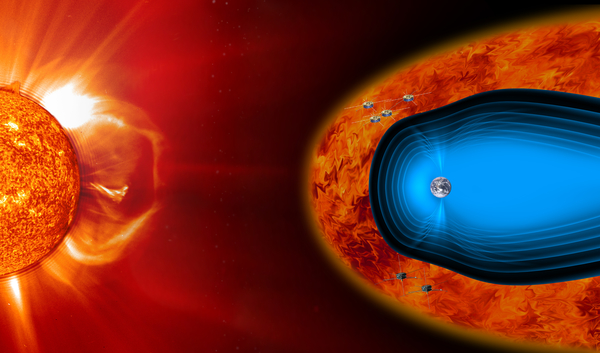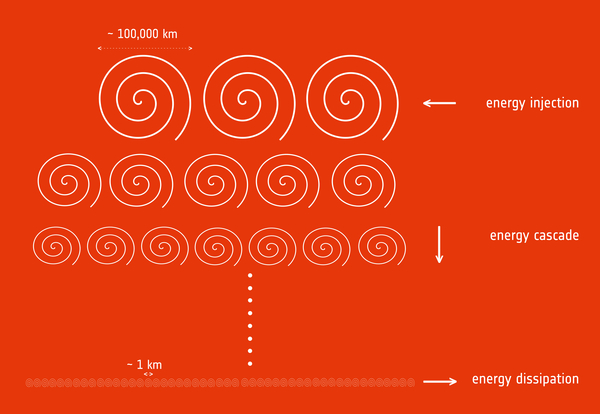Cluster measures turbulence in Earth's magnetic environment
29 January 2018
For the first time, scientists have estimated how much energy is transferred from large to small scales within the magnetosheath, the boundary region between the solar wind and the magnetic bubble that protects our planet. Based on data collected by ESA's Cluster and NASA's THEMIS missions over several years, the study revealed that turbulence is the key, making this process a hundred times more efficient than in the solar wind. |
| The magnetosheath in Earth's magnetic environment. Credit: ESA (background and Cluster spacecraft); NASA (THEMIS spacecraft) |
The planets in the Solar System, including our Earth, are bathed in the solar wind, a supersonic flow of highly energetic, charged particles relentlessly released by the Sun. Our planet and a few others stand out in this all-pervasive stream of particles: these are the planets that have a magnetic field of their own, and so represent an obstacle to the sweeping power of the solar wind.
It is the interaction between Earth's magnetic field and the solar wind that creates the intricate structure of the magnetosphere, a protective bubble that shields our planet from the vast majority of solar wind particles.
So far, scientists have achieved a fairly good understanding of the physical processes that take place in the solar wind plasma and in the magnetosphere. However, many important aspects are still missing regarding the interplay between these two environments and about the highly turbulent region that separates them, known as magnetosheath, where it is suspected that most of the interesting action happens.
"To learn how energy is transferred from the solar wind to the magnetosphere, we need to understand what goes on in the magnetosheath, the 'grey area' between them," says Lina Zafer Hadid, from the Swedish Institute of Space Physics in Uppsala, Sweden.
Lina is the lead author of a new study that quantifies, for the first time, the role of turbulence in the magnetosheath. The results are published today in Physical Review Letters.
"In the solar wind, we know that turbulence contributes to the dissipation of energy from large scales of hundreds of thousands of kilometres to smaller scales of a kilometre, where plasma particles are heated up and accelerated to higher energies," explains co-author Fouad Sahraoui from the Laboratory of Plasma Physics in France.
"We suspected that a similar mechanism must be at play in the magnetosheath too, but we could never test it until now," he adds.
 |
| Energy cascade in turbulent plasma. Credit: ESA |
The magnetosheath plasma is more turbulent, home to a greater extent of density fluctuations and can be compressed to a much higher degree than the solar wind. As such, it is substantially more complex, and scientists have only in recent years developed the theoretical framework to study the physical processes taking place in such an environment.
Lina, Fouad and their collaborators combed through a vast volume of data collected between 2007 and 2011 by the four spacecraft of ESA's Cluster and two of the five spacecraft of NASA's THEMIS missions, which fly in formation through Earth's magnetic environment.
When they applied the recently developed theoretical tools to their data sample, they were in for a big surprise.
"We found that density and magnetic fluctuations caused by turbulence within the magnetosheath amplify the rate at which energy cascades from large to small scales by at least a hundred times with respect to what is observed in the solar wind," explains Lina.
The new study indicates that about 10-13 J of energy is transferred per cubic metre every second in this region of Earth's magnetic environment.
"We expected that compressible turbulence would have an impact on the energy transfer in magnetosheath plasma, but not that it would be so significant," she adds.
In addition, the scientists were able to derive an empirical correlation that links the rate at which energy is dissipated in the magnetosheath with the fourth power of another quantity used to study the motion of fluids, the so-called turbulent Mach number. Named after Austrian physicist Ernst Mach, it quantifies the speed of fluctuations in a flow with respect to the speed of sound in that fluid, indicating whether a flow is subsonic or supersonic.
While the energy transfer rate is tricky to determine unless using space probes that take in situ measurements, like the Cluster spacecraft sampling the plasma around Earth, the Mach number can be more easily estimated using remote observations of a variety of astrophysical plasma beyond the realm of our planet.
"If this empirical relation turns out to be universal, it will be extremely useful to explore cosmic plasma that cannot be directly probed with spacecraft, such as the interstellar medium that pervades our Milky Way and other galaxies," says Fouad.
The scientists are looking forward to comparing their results with measurements of the plasma surrounding other Solar System planets with an intrinsic magnetic field, for example using NASA's Juno mission, currently at Jupiter, and ESA's future Jupiter Icy Moons Explorer, and also the joint ESA-JAXA BepiColombo mission to Mercury that is scheduled for launch later this year.
"It is very exciting that a study based on several years of Cluster data has found the key to address a major, long unsolved question in plasma physics," says Philippe Escoubet, Cluster Project Scientist at ESA.
Notes for Editors
The paper "Compressible magnetohydrodynamic turbulence in the Earth's magnetosheath: estimation of the energy cascade rate using in situ spacecraft data" by L. Z. Hadid et al. is published in the journal Physical Review Letters. doi: 10.1103/PhysRevLett.120.055102.
Cluster is a constellation of four spacecraft flying in formation around Earth. It is the first space mission able to study, in three dimensions, the natural physical processes occurring within and in the near vicinity of the Earth's magnetosphere. Launched in 2000, it is composed of four identical spacecraft orbiting the Earth in a pyramidal configuration, along a nominal polar orbit of 4 × 19.6 Earth radii (1 Earth radius = 6380 km). Cluster's payload consists of state-of-the-art plasma instrumentation to measure electric and magnetic fields over wide frequency ranges, and key physical parameters characterising electrons and ions from energies of near 0 eV to a few MeV. The science operations are coordinated by the Joint Science Operations Centre (JSOC) at the Rutherford Appleton Laboratory, United Kingdom, and implemented by ESA's European Space Operations Centre (ESOC), in Darmstadt, Germany.
More information on the Cluster mission can be found here.
NASA's Time History of Events and Macroscale Interactions during Substorms (THEMIS) consists of five identical probes to study the violent colourful eruptions of aurorae. When THEMIS' prime mission concluded in 2010, two of its five spacecraft were repurposed as ARTEMIS and were moved to lunar orbits to study the moon's interactions with the Sun.
More information on the THEMIS and ARTEMIS mission can be found here.
Corrigendum
The original article previously stated: "The new study indicates that about 1013 J of energy is transferred per cubic metre every second in this region of Earth's magnetic environment." This has now been corrected to: "The new study indicates that about 10-13 J of energy is transferred per cubic metre every second in this region of Earth's magnetic environment."
For further information, please contact:
Lina Zafer Hadid
Swedish Institute of Space Physics
Uppsala, Sweden
Phone: +46 18 471 5934
Email: lina.hadid![]() irfu.se
irfu.se
Fouad Sahraoui
LPP, CNRS, Ecole Polytechnique, Université Paris-Sud, Observatoire de Paris, Université Paris-Saclay, Sorbonne Université, PSL Research University
France
Phone: +33 1 6933 5922
Email: fouad.sahraoui![]() lpp.polytechnique.fr
lpp.polytechnique.fr
C. Philippe Escoubet
Cluster Project Scientist
Directorate of Science
European Space Agency
Phone: +31 71 565 3454
Email: Philippe.Escoubet![]() esa.int
esa.int


